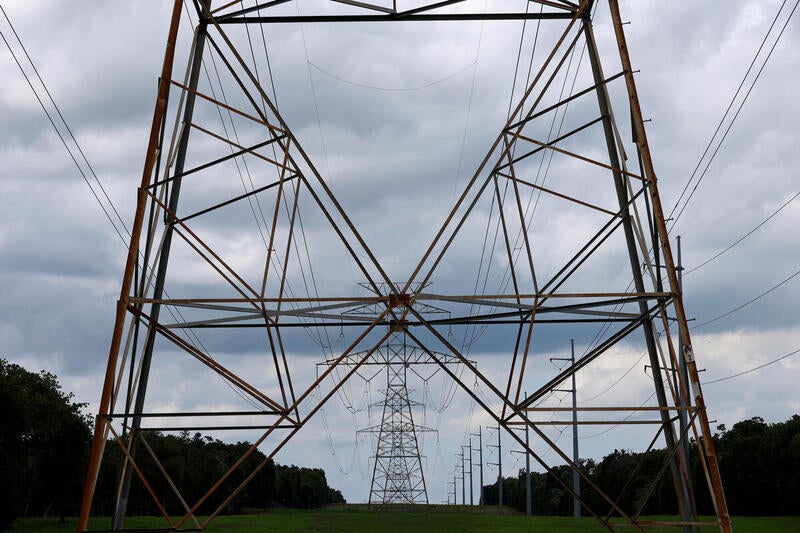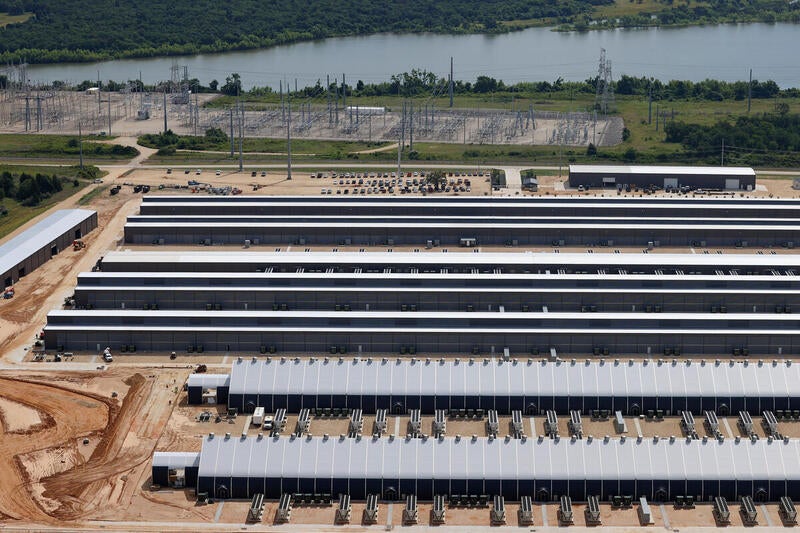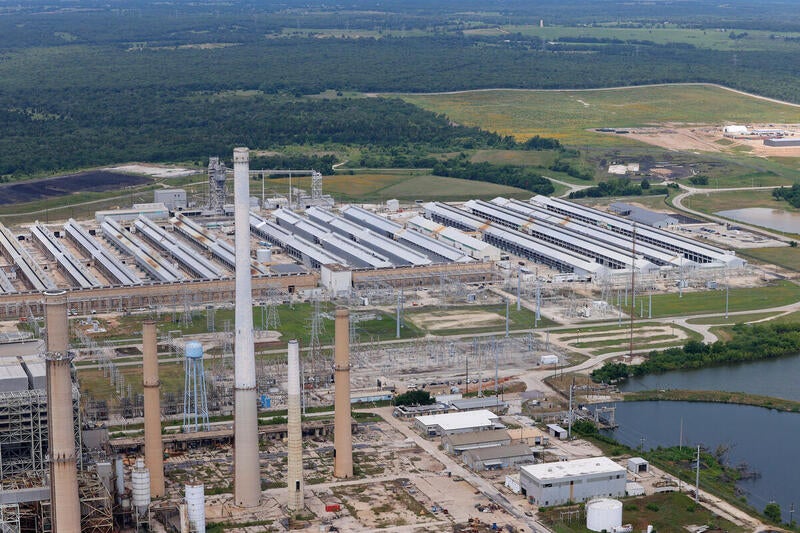The Impacts of Cryptomining
September 12, 2023
Cryptocurrency Mining in Texas
After China banned cryptocurrency mining in 2021, cryptomining increased significantly in the United States. Texas quickly emerged as a top state for large-scale cryptomining operations.
The rapid growth of cryptomining threatens to strain Texas’s grid and raise electricity rates for Texans.
On this Page
Proof-of-work cryptocurrency mining such as Bitcoin consumes vast amounts of energy as millions of computers race to solve a complex algorithm and win digital currency.
Cryptocurrency mining companies in Texas filed applications to connect new facilities to the grid with a projected demand of nearly 42 GW of electricity in 2027, enough electricity to power more than 8.3 million Texas homes during periods of peak demand.

As cryptocurrency mining expands, it becomes less lucrative for each of the participants, more competitive, and more energy-intensive.
In Texas, cryptocurrency mining operations benefit from
- reduced electricity rates,
- tax subsidies, and
- incentive programs.
Together, these handouts to cryptocurrency companies mean huge profits, often at the expense of everyday Texans paying a monthly electricity bill.
Cryptomining operations profit from the state’s demand-response programs, which pays them whether or not they actually shut down. Demand-response programs are designed to stabilize the grid, not subsidize the expansion of energy-intensive industries. And demand-response programs are not offered to residential electricity users in Texas, instead the outsized financial benefits go to crypto miners. Cryptomining operations also make millions playing Texas’s deregulated energy market by selling electricity back to the grid at peak times.
Explosive Growth of Cryptomining in Texas
A one-megawatt crypto mine consumes more energy each day than 700 American homes. As of April 2023, five of the 10 largest Bitcoin cryptocurrency mines were located in Texas.
- Riot Platforms in Rockdale, TX, uses 450 MW
- Cipher Mining in Odessa, TX, uses 207 MW
- US Bitcoin in Upton County TX, uses 200 MW
- Rhodium Enterprises in Temple, TX, uses 185 MW
- Bitdeer in Rockdale, TX, uses 170 MW
A megawatt (MW) is a measure of instantaneous power flow.
The top five Bitcoin mines in Texas use a total of 1212 MW today, which is as much energy as 242,400 Texas homes.
The Texas Comptroller office recently stated,
“It is hard to say how many mines are operating in the state, as there are no requirements to register operations, but according to the Texas Blockchain Council, there are at least 27 mining operations, with more on the way.”
The lack of transparency and regulation of these highly polluting and energy intensive operations means the public and regulators cannot fully understand the true impact of their operations on local communities and the climate.
Cryptomining Will Drive Up Electricity Prices for Everyone Else
A recent BloombergNEF report found that energy prices in Texas will soar for consumers if Bitcoin mining continues its rapid expansion in Texas. Models show peak energy prices increasing by 30% in one scenario in which the amount of cryptomining peak load roughly triples, and increasing by around 80% in a scenario in which the amount of cryptomining peak load increases around sixfold.*
The report states:†
“ERCOT power prices will be a function of new bitcoin mining facilities.”

Cryptomining Consumes Vast Amounts of Energy
Cryptomining operations consume vast quantities of energy and run around the clock. Crypto miners can plug in and purchase electricity from a local utility, establish custom power purchase agreements with fossil-fuel power plants or utilities, purchase their own power plants to supply energy to mining rigs “behind-the-meter," or burn fossil gas right at oil and gas wells.

Most U.S. mining facilities draw power from the grid. Adding a new large-scale load, like a cryptocurrency mining facility, to the grid generally requires existing fossil generators to increase their output. Mining facilities located near wind or solar sites do not have a special claim to energy produced by that energy, but instead drive increased emissions from gas and coal plants.
Texas produces more wind power than any other state, but the power demands from cryptomining far exceed the hourly supply of renewable energy in the state.
Record Windfalls From Reselling Electricity Back to the Grid in Texas
The nature of Texas’s independent electricity market provides cryptomining operations with unique opportunities to profit in ways that drive up costs for others. The Electric Reliability Council of Texas (ERCOT) maintains the state’s independent power grid free from federal oversight. But isolation also makes Texas more vulnerable. Texas’s deregulated electricity market leads to price extremes (both low and high). Crypto mines take advantage of extreme weather by reselling electricity back to the grid.
While Winter Storm Uri was a disaster for Texans, as 69% of Texans lost electricity, it was a windfall for crypto mines. Inflated prices of electricity from retail electric suppliers during the winter storm meant that crypto miners could sell electricity back to grid at an enormous profit. While some consumers were charged $2,000 a day to stay warm, one crypto miner resold electricity back to the grid and made $125 million. The state of Texas still owes that miner $86 million, which will be paid for by Texas utility customers.
Extreme heat in the summers, like extreme cold in the winter, can be a windfall for crypto mines. For example, during heatwaves in June 2023, Riot Platforms made $8.4 million from selling electricity back to the grid, and Cipher Mines made $1.2 million.


ERCOT Demand-response Programs Give Away Millions to Crypto Miners
By increasing the demand on the grid, crypto miners increase the need for demand-response, the cost of such programs, and the cost of providing electricity to all other customers: ERCOT’s independent market monitor expects that Texans could be paying an extra $1.5 billion for electricity in 2023 – in part to pay cryptocurrency miners to shut down their operations during high demand.
In Texas, crypto miners can participate in ERCOT’s demand-response program (Responsive Reserve Service) and be paid by the grid operator for agreeing to shut down operations to prevent blackouts. The program pays crypto operations even if they are not actually asked or required to shut down. Many facilities may only shut down for only a few hours a year but can make millions of dollars. Demand-response company Voltus estimates that a cryptocurrency mining company can generate up to 10% of its annual revenue by providing shutdown services to the grid.
$60M
Five facilities in Texas collectively made at least $60 million from this program since 2020.
$9.3M
In July 2022, the Riot mine in Texas was asked to shut down for a total of nearly 3.5 hours but made about $9.3 million from the program.
$1.6M
In June 2023, during just the beginning of the summer heat waves, Riot Platforms made $1.6 million from the demand-response program.
These payments are made to participating users whether or not the user would have elected to shut down operations without a request, due to high energy prices at the time of system risk. Compounding this inequity, most cryptomining equipment cannot physically operate in Texas’ extreme heat.

Crypto Miners in Texas Get Deep Discounts on Electricity Rates
Cryptomining facilities receive reduced electricity rates from utilities and retail electric suppliers. Even though they use more energy than surrounding homes, they can pay as little as 15% of what residences pay for electricity.
When energy demand soars, ERCOT charges fees to high energy users. But crypto mines dodge these fees by predicting when they will be assessed and shutting off operations.
$27M Avoided
One summer day in 2022 when energy demand spiked, the Riot mine reduced its operations by 99% so it did not trigger the fee.
Mere hours later, it resumed operating. It avoided a potential $27 million in fees that year by shutting down at times these fees were assessed.
Tax Incentives for Cryptomining in Texas
Cryptomining operations receive local and state tax incentives that other electricity users do not. For example:
Riot is exempt from the 6.25% state sales tax for items that are “necessary” to its operation — including electricity — and receives an abatement on facility improvements for an estimated taxable value of $151,320,000.‡
The City of Corpus Christi is foregoing $7 million annually in sales tax and franchise fees, equating to $70,501,509 over ten years, to accommodate Bootstrap Energy’s $1.1 billion cryptocurrency mining operation.
The state also offers a blanket sales/use tax exemption for crypto miners’ electricity use and other tax benefits granted to data centers if they spend over a certain threshold on investments.
Communities Foot The Bill When Crypto Mines Relocate
Adding crypto mines to the grid sometimes requires the construction of expensive transmission and distribution lines, but often nothing stops them from leaving an area if a cheaper opportunity arises somewhere else. For example:
$700K
A mining operation in Washington State declared bankruptcy, leaving more than $700,000 in debt for grid upgrades that were paid for by ratepayers. In Arkansas, after a utility invested in expensive upgrades on its behalf, the crypto mine left “virtually overnight” to seek cheaper electricity rates elsewhere.
$40M
The Rayburn County Electric Cooperative in North Texas found that serving two cryptocurrency mines interested in connecting to the utility’s service territory north and east of Dallas would require up to $40 million to fortify power lines to avoid blackouts while consuming enough electricity to power as many as 60,000 Texas homes.
Cryptocurrency Mining Impacts Neighbors
Cryptomining’s harms are not limited to its electricity use or the additional air pollution from generating all the electricity necessary to mine cryptocurrency.
Crypto mines require large amounts of water for cooling and create significant noise pollution for neighbors
Cryptomining diverts valuable water resources year-round
Riot Bitcoin, the largest Bitcoin mine in the United States, is located in drought-stricken Navarro County, Texas. Water shortages during 2022 summer months, forced ranchers to sell cattle in record numbers not seen in a decade. But the City of Corsicana plans to sell its water to Riot Bitcoin, which will use 1.5 million gallons of water per day in peak summer months.§
Crypto mines create significant noise pollution
Crypto mines’ fans create significant noise pollution. Many crypto mines use fans to cool their banks of computers. The roar of fans used to cool computers can reach 95 decibels, which is like standing next to a running motorcycle, a highway, or an idling semi. Residents within a mile of a mine located in the town of Murphy, NC, hear the roar year-rounds.
Crypto Mines Often Promise Jobs, But Do Not Deliver
Crypto mines promise, but do not bring, substantial jobs to communities. These facilities use vast amounts of energy and water but require few employees to keep the machines running. For example, a mine in Rockdale, TX, promised to create more than 300 jobs but only hired 14 people.

The massive energy consumption of proof-of-work cryptocurrency mining threatens to undermine decades of progress towards achieving climate goals, and threatens grids, utilities, communities, and ratepayers. Regulators and policymakers must take steps to reduce the harms of cryptocurrency mining. Learn more on cryptocurrency.
Footnotes
* Natathalie Limandibhratha & Tom Rowlands-Rees, ERCOT Market Outlook: Everything Depends on Bitcoin, BloombergNEF, at 22 (Feb. 14, 2023).
† BLOOMBERGNEF, at 2.
‡ Files available upon request; obtained via public records requests.
§ Source document available upon request.
Earthjustice’s Clean Energy Program uses the power of the law and the strength of partnership to accelerate the transition to 100% clean energy.